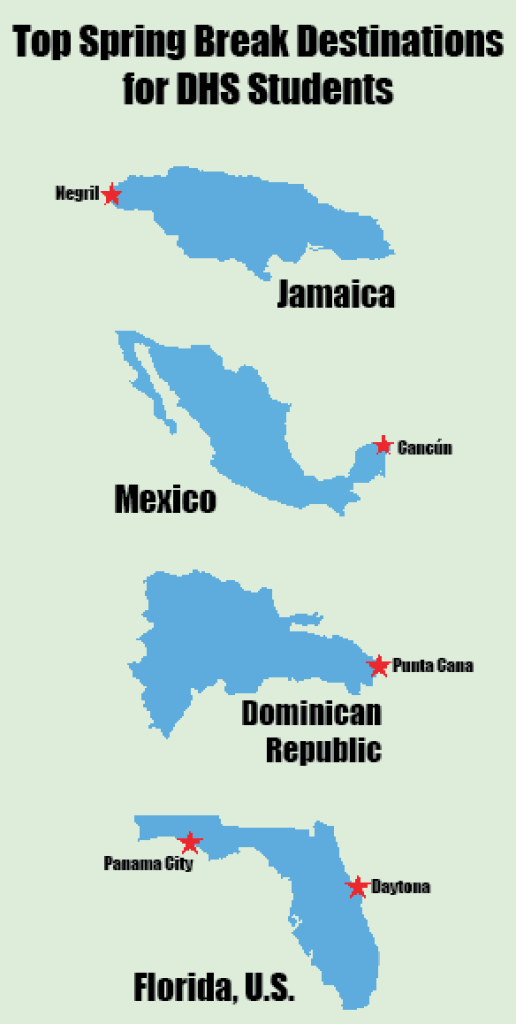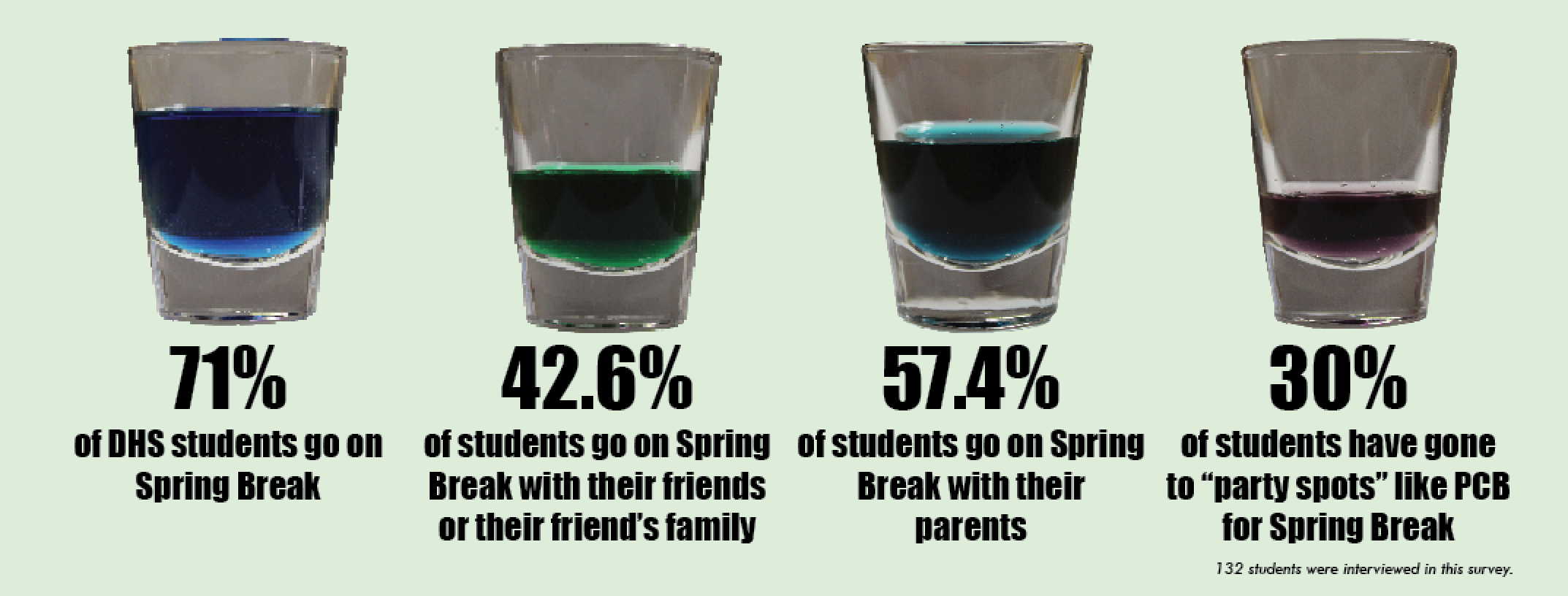As underage drinking levels rise at Spring Break destinations, the consequences are seen as less and less severe to high schoolers
By Michael Bradshaw & Claire Ward
Two anonymous Dexter High School Students were interviewed for the article. They will be referred to as John and Susan throughout the text.
Panama City Beach. Mexico. Siesta Key. Daytona. These places all have many things in common. They have beaches, are warm, are common Spring Break destinations, and have a major underage drinking presence.
As a teen grows up they drift from the magical Disney vacations to the partying at Panama City Beach. Their mascot of choice changes from Mickey Mouse to Captain Morgan.
“I think [students] are educated, I just don’t think they care. I think the education is out there; I think kids think they’re immortal.” –Brian Baird
Spring Break and underage drinking have been connected for years. It influences where people decide to go on Spring Break and the types of activities they participate in. Miami Beach and Panama City Beach have been notoriously known for late-night, mile-long beach parties. Panama City sees close to 500,000 student visitors each year, flooding beaches and hotels. New ordinances have recently been passed in Florida, requiring party-goers to carry valid ID’s and bars/clubs to close no later than 2 A.M., but arrests of underage drinkers still remains close to 300 people over the past few weeks in Bay County (where Panama City Beach is). Despite stronger police efforts, thousands of underage students can get away with drinking and partying inside a mix of thousands of college students.
One of the major problems is that teens don’t view underage drinking as a bad thing. Society as a whole has become desensitized to the illegality of it. Most teenagers don’t drink as often as adults do, but when teenagers do drink they are more likely to binge than adults are. According to the Center for Disease Control, underage drinking is responsible for 11% of all alcohol consumption in the U.S., and 90% of this alcohol is consumed through binge drinking. One of the biggest dangers accompanied with binge drinking is alcohol poisoning, which can later lead to liver damage and breathing issues.
“Nobody thinks that [underage drinking] is illegal anymore,” John said. “They just drink it because they think ‘Why not?’”
This attitude of “Why not?” has influenced teens and their Spring Break destinations. John is going to Daytona, Florida, for Spring Break this year, and one reason why this was a destination of choice was the partying image of Daytona. Although John was still considering safety.
“We wanted to be safe [in regards to potentially dangerous people] , so we could party,” John said.
Not only is John going to Daytona this year, but John has gone to Panama City Beach multiple times in the past and believes teens’ number one goal for Spring Break is to go to a partying destination.

In research supported by the National Institute on Alcohol Abuse and Alcoholism, it was discovered college-age students (18-24) consume more alcohol per person during Spring Break over any other time of the year, passing the Fourth of July and New Year’s Eve. High school age partiers get mixed up with the mess of college students, fading away from police as they all fit together with the party going on.
All the blame may not fall onto the teens themselves though. Some of the underage drinking may be attributed to parents and their decisions about Spring Break.
“Personally, I think that’s dangerous to let 17 year olds go some place like that on their own,” said Dexter High School math teacher and women’s lacrosse coach Brian Baird. “I don’t condone it. I don’t think it’s safe or smart.”
Many parents do not hold the same views as Baird, and make the choice to let their children travel out with friends to partake in activities viewed as “normal” Spring Break behavior today.
Teens that participate in this “normal” behavior may not understand the potential consequences surrounding drinking. Many Spring Breakers think spending a week partying and drinking at PCB won’t have a large effect on their lives once they return to Michigan, but it can change lives in more ways than a high schooler may think. Athletic participation, college acceptance, and even a student’s legal record may be impacted if caught.
“Half the people, if they got caught, would have no idea what would happen to them,” John said.
Dexter High School athletic teams all follow the same policy of temporary to long-term suspension depending on the weight of cause. Some sports have their own policies in addition to school policies, determined by the head coach, that can sometimes result in the student being kicked off the team.
One DHS student athlete regretted some of her actions once she had to face the repercussions of underage drinking.
“Looking back on it, I didn’t realize the extent of the consequences and how they would affect me, how people saw me, and my playing time,” Susan said.
Losing time in a game or being close with a team is not the only result of binge drinking for a week straight in April.
“Obviously we have school rules that we follow for playing time with an athlete,” Baird said, “but I think there’s a lot of physical aspects that if the student has been drinking regularly can affect how they perform.”
Some may say schools need to educate students more about this growing issue of underage drinking, but is it possible for schools to change the minds of teenagers across the country?
“I think [students] are educated, I just don’t think they care,” Baird said. “I think the education is out there; I think kids think they’re immortal.”

